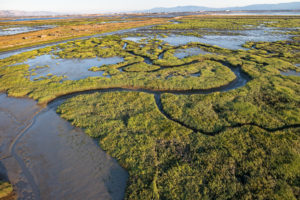
With their broad ears, cinnamon belly, and eyes as wide as a surprised child’s, salt marsh harvest mice present an unusual mix of adorable and mysterious, the baby Yodas of rodents. When caught in high water in San Francisco Bay’s tidal marshes, they will climb to the uppermost joint of a pickleweed stem and hang on with their tiny pink appendages for dear life. When they’re caught by a person, they’re more inquisitive. At Suisun Marsh one early morning last fall, a mouse explored the edges of a clipboard and posed for a photograph before scampering back to its burrow. “Every mouse I take out of a trap I fall in love with,” said Katie Smith, a wildlife biologist and the mouse’s captor. “They’re very sweet.”
Still, despite the fact that the mouse is the only mammal that scrapes out its existence exclusively in tidal marshes, no one has ever bothered to seriously study its physiology. It can swim better than most rodents, but we don’t know why. (We suspect its long tail might help stabilize it in the water.) It can survive on salty water, an ability researchers dissecting mice in the 1960s attributed to extra-developed kidneys. (We’re still not sure.) Until recently, even the mouse’s diet had never been properly investigated. Because the species was commonly found in dense patches of pickleweed, scientists assumed that’s what it preferred to eat.
Almost the only thing we know for certain is that since the 1850s, some 90 percent of its habitat has been diked, drained, built on, and plowed under. “When I started trapping the mouse, I realized it was already in a difficult situation,” says Howard Shellhammer, known by many as the godfather of salt marsh harvest mouse research. As a biology professor at San José State in the 1960s, Shellhammer (now 84) saw the mice as proxies for the tragedy of the Bay’s vanishing marshes. In 1970, he successfully applied to have the endemic species, which is found only in the marshes of San Francisco Bay, listed as federally endangered.
Now, new research led by Smith is overturning many of our old assumptions. We once thought, for example, that managed wetlands—where water level is controlled by a system of levees instead of the push and pull of the moon’s gravity, and where plants that attract waterfowl are often prioritized over pickleweed—were marginal territory for the mouse. Yet recent studies show they can support healthy populations of salt marsh harvest mice. Our understanding of their favorite food choices has changed, too. In one experiment, Smith trapped nearly 300 mice at Suisun Marsh and offered them a miniature buffet of plants found in both tidal and managed wetlands. Not only did they happily munch on nonnative plants, but in most cases, they preferred those over pickleweed.
Most plans for mouse recovery have involved restoring managed wetlands to natural tidal conditions, but Smith’s findings flip that objective on its head. “If you have to make a decision between converting a managed wetland to a tidal marsh or enhancing a lot of managed wetlands,” Smith says, “to me, it’s obvious which choice would benefit [this] species more.” Sea level rise is another factor to consider. Studies estimate that by 2100, more than 90 percent of the few tidal marshes that remain could be underwater.
Just as a lot of what we knew about salt marsh harvest mice has changed, I think the species has come to represent something entirely different than what those who first studied it imagined. Even with the loss of tidal marshes, Smith’s research suggests we have the ability, in the long run, to keep the salt marsh harvest mouse from vanishing entirely.
Smith argues that the species is “an exemplar of reconciliation ecology,” an approach that aims to build biodiversity in human-dominated landscapes without decreasing that human utility. I asked her if whether learning earlier that the mouse shares favorite foods with ducks and other waterfowl could have made a difference in the survival of the mouse? “Probably not,” Smith replied, “We have a limited amount of space to enact recovery plans.”
Today we find ourselves doing the most we can for wildlife with the wetlands that remain. “There’s no way we’re going to make the marshes the way they were before European colonization,” Smith says.
The San Francisco Bay of the future will feature a few scattered tidal marshes, many managed wetlands, and lots of water, she adds. We need to find value in the habitat we have.




